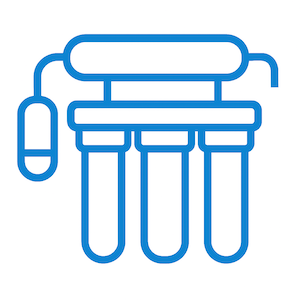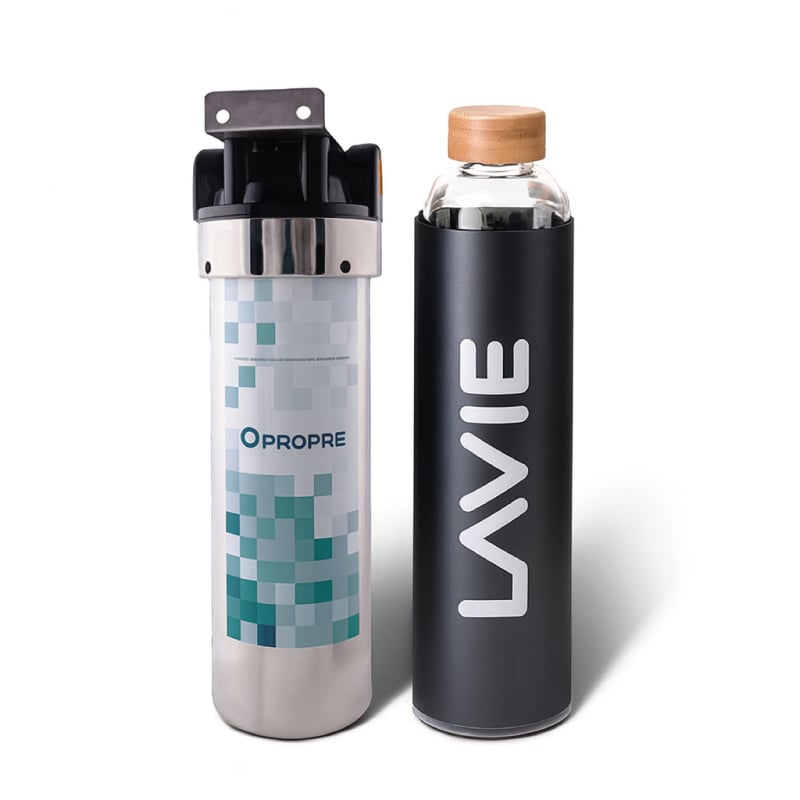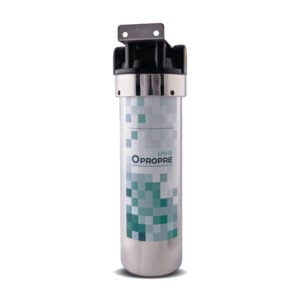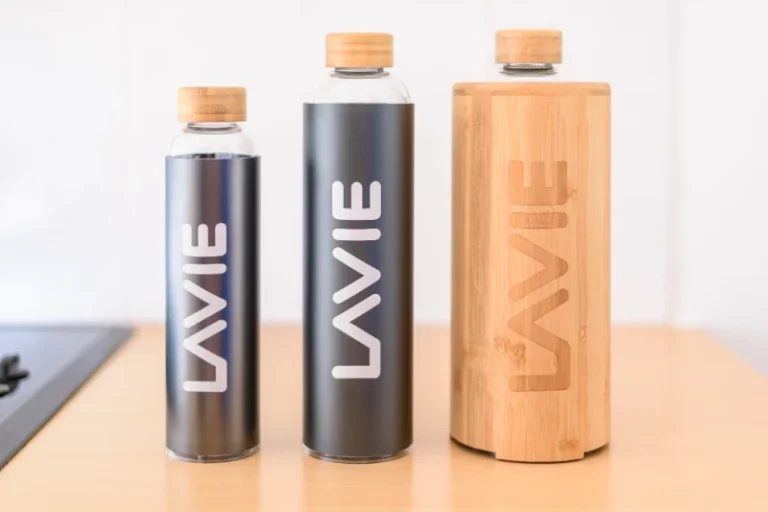
30-day money-back guarantee *

In the wake of a number of recent tap water pollution scandals, more and more households are looking to improve the quality of their water thanks to filtration solutions. The domestic osmosis system is regularly presented as the most efficient system on the market, and with good reason: it is said to remove up to 99% of contaminants from water.
So efficient, in fact, that the osmosis unit even removes the naturally occurring beneficial minerals in our drinking water, which raises questions about the safety of consuming reverse osmosis water (considered non-drinking as defined by the WHO!). Not to mention its ecological impact: the osmosis machine consumes 3 to 4 litres of water to produce just 1 litre of purified water.
So, is the osmosis unit for the tap a miracle solution for healthier water, or is it too radical a system, impacting both the wallet and the planet? That's what we'll be looking at in this article.
An osmosis plant is a device for water purification based on the principle ofreverse osmosis. It uses a semi-permeable membrane to eliminate dissolved impurities, such as mineralsthe heavy metalsand some organic contaminants. This system is sometimes used in homes to improve the quality of tap water, although it is more widespread in industry and laboratories.
An osmosis unit filters water in three main stages:
So no, reverse osmosis systems don't promise anything, we agree ;). But let's go back to the supposed benefits that the installation of a domestic osmosis system and the production of osmosis water should bring you.
In general, manufacturers put forward the following arguments:
Our use of the conditional tense above should surely make you understand by now that, in our view, these arguments are, at best inaccurateat worst, downright fake.
In this article, we'll show you why you don't need a reverse osmosis system in your home.
As you can see from the table above, theReverse osmosis has a number of disadvantagesThe main one is the high consumption of water to produce a small quantity of purified water (water which, as well as being wasted, is concentrated in pollutants and will be discharged into the environment!)
What's more, minerals essential to good health (such as magnesium and calcium) are also removed, leaving the water depleted of nutrients. Let's take a closer look at these various disadvantages.
💧 Read also : Reverse osmosis: what are the advantages and disadvantages?
First of all, let's talk about a strong trend in the current market for products sold to treat water and improve its quality: we are seeing a steady stream of recurring revenue products.
Filter jugs, water softeners, osmosis units and many others, make us buy consumables (mostly filters) on a regular basis.
It's all aboutrecurring purchases which will add to your household budget (as well as generating a certain amount of non-recyclable waste).
To illustrate this further, let's take a look at a basic package, available on the market for around €250. You should be aware that a standard osmosis unit costs more in the 1500€So this is a 'first prize'.
If you can install it yourself, great, if not double the price of the appliance to include installation, i.e. almost €500 once installed (here's a video detailing how to install an under-sink reverse osmosis unit: not so easy!)
Let's do the maths: you'll need to spend around €100 every 6 months to change the filters, and €70 to replace the membrane. Over 3 years, that works out at an extra €500 for maintenance, or a budget of €1,000 to €1,500 for the purchase, installation and maintenance of your osmosis unit !
You also need to take into account the energy cost of running the appliance's electric pump, as well as the extra water consumption (on average), 3 litres of water are rejected for 1 litre of osmosis water).
So it's hard to see this as a benefit!
An osmosis plant is originally a product designed for Nasa space stations or boatsThe osmosis process can be used to recycle salt-laden water or urine, for example. But as salt is regulated in drinking water, there is no point in osmosing tap water.
These appliances produce osmosis water ultra-processed, "deadunfit for consumption, and therefore "unfit for human consumption" in the sense of minerals and dissolved oxygen. undrinkable ! Drinking water must contain as a minimum from calcium and magnesium. in regulated quantities from which this device will have extracted 80 to 90% through its membrane. Before investing in a filtration system, it is therefore important to find out about the possible dangers of reverse osmosis for your health.
💧 Read also : Does reverse osmosis make water unsafe to drink?
According to the WHOa drinking water should be in the region of a Neutral pHor between 6.5 and 8.5, ideally 7.5. Nevertheless, your osmosis plant will produce osmosis water that will be acid, corrosiveA water filter with a pH value of around 6 is just as good as a water filter...
💧 To find out more : Understanding the pH of tap water
A drinking water contains little or no bacteria. However, the 6-litre tank in your reverse osmosis unit, stripped of the chlorine that used to protect the water from contamination, will quickly become a nest for these little creatures (as with filtering carafes).
💧 To read: What are the alternatives to a carafe filter?
Finally, don't forget that osmosis water is stored at 20°C, or even 30°C in summer, which is a very high temperature. temperature highly conducive to bacterial growth.
So, of course, some more expensive models incorporate mineralisation cartridges (calcium and magnesium). Another excellent way of catching a few more bacteria. And.., why would you want to artificially put what naturally went in?
Carafe filter, tap-mounted or under-sink filter, UV-A purifier... how do you choose between all these options? best tap water filter ?
Here is a table comparing the elements filtered by the products in the LAVIE range compared with other solutions on the market (including domestic osmosis).
|
Element filtered, reduced or eliminated |
Classic carafe filter |
Tap filter |

Osmosis unit |

Opropre under-sink filter |

LAVIE Purifier |

Peace of mind pack (Opropre + LAVIE PURE) |
| Chlorine | ✅ | ✅ | ✅ | ✅ | ✅ | ✅ |
| Sediment | ✅ | 🟠 | ✅ | ✅ | ❌ | ✅ |
| Bacteria | ❌ | ❌ | ❌ | ❌ | ✅ | ✅ |
| Virus | ❌ | ❌ | ❌ | ❌ | ✅ | ✅ |
| Medicines | ❌ | ❌ | ✅ | ✅ | ✅ | ✅ |
| Pesticides | ❌ | ❌ | ✅ | ✅ | ✅ | ✅ |
| Heavy metals | 🟠 | 🟠 | ✅ | ✅ | ❌ | ✅ |
| PFAS | ❌ | ❌ | ✅ | ✅ | ❌ | ✅ |
| Microplastics | ❌ | ❌ | ✅ | ✅ | ❌ | ✅ |
| Mineral conservation beneficial |
❌ | 🟠 | ❌ | ✅ | ✅ | ✅ |
| Discover | Discover | Discover |
💧 Read also : Comparison of the best home filtration systems
Our under-sink filters Opropre uses high quality coconut activated carbon to remove chlorine, heavy metals, pesticides, microplastics and other contaminants from tap water, while preserving all the trace elements beneficial to the body.
To combat PFAS, we have also developed a specific ion exchange resin in our filters. Opropre Turquoisewhich targets these persistent pollutants.
Easy to install and with no water discharge, the cartridges in our Opropre filters are also designed to be returnable and reusableThis reduces waste and its impact on the environment. Once used, they are returned to LAVIE to be refilled with new activated carbon, while the used carbon and anti-PFAS resin are recovered and recycled in specialised industrial circuits.

💧 Read also : What's the best under-sink filter?
Although reverse osmosis has the reputation of "filtering everything" thanks to the pressure exerted on its membrane, it does so at the cost of numerous compromises: wasted water, loss of minerals, restrictive and costly maintenance, etc.
Conversely LAVIE water purifiers are based on an innovative, natural and much more sustainable technology. Our filter carafes use UV-A radiation to eliminate pesticides, chlorine, drug residues, bacteria and viruses, while preserving all the benefits of water.
It's simple: no filters to change, no disposable plastic, and above all no water discharge ! To find out more about our patented technology, click here to see all our products. tests and scientific advice.

As you will have gathered from this article, a reverse osmosis system is far from being the best solution for improving the quality of tap water. It is true that it eliminates up to 99 % of contaminants thanks to its membrane, but at the cost of a number of disadvantages: it rejects 3 to 4 litres of polluted water to produce a single litre of purified water, it removes essential minerals from the water such as calcium and magnesium, and it is expensive to purchase and maintain. among the most expensive on the market.
In addition, theosmosis water is acidic and more vulnerable to bacteria, which raises questions about the health risks associated with its consumption.
Fortunately, there are several effective alternatives. The Opropre under-sink filters associated LAVIE UV-A purifiers offer you the same high level of filtration as osmosis systems, without compromising your wallet or the environment! With LAVIE products, you can enjoy pure, healthy water every day.
Osmosis water is depleted of essential minerals such as calcium and magnesium, becomes acidic and is more vulnerable to bacteria. It is even considered undrinkable as defined by the WHO!
It is therefore not recommended for daily consumption, especially for frail people.
Alternatives to reverse osmosis are more suitable for domestic use. The LAVIE UV-A purifiers and Opropre under-sink filters eliminate pesticides, chlorine, drug residues and heavy metals just as effectively, while preserving the essential minerals in the water. Simple, economical and much more durable, these systems allow you to enjoy healthy, pure water at home.
An osmosis plant works by reverse osmosis It retains almost all the particles in the water thanks to several filters and a membrane (including beneficial minerals). To operate, this system wastes a lot of water: over 3 litres of polluted water are rejected to obtain just 1 litre of filtered water!
Water filters such as Opropre under-sink filters use activated carbon to remove contaminants from the water while preserving all the minerals that are beneficial to health. They require less maintenance and are more environmentally friendly.
Finally, water purifiers like those from the LAVIE range simply do not use filters, but a natural reaction (the photolysis of chlorine) triggered by UV-A rays that destroy chlorine, bacteria, pesticides, drug residues, etc. A much healthier, more ecological and economical solution than osmosis!
An entry-level osmosis unit costs around €250, while a standard model costs closer to €1,000 to €1,500. Then there's the cost of professional installation (around €500) and regular maintenance (around €200 a year to replace the filters and membrane).
Over 3 years, the total budget can therefore exceed 1 500 à 2 000€Not to mention higher water and electricity bills!
Want to keep up to date with our water-related articles?
Subscribe to our Newsletter below
and get -5% on your first order!